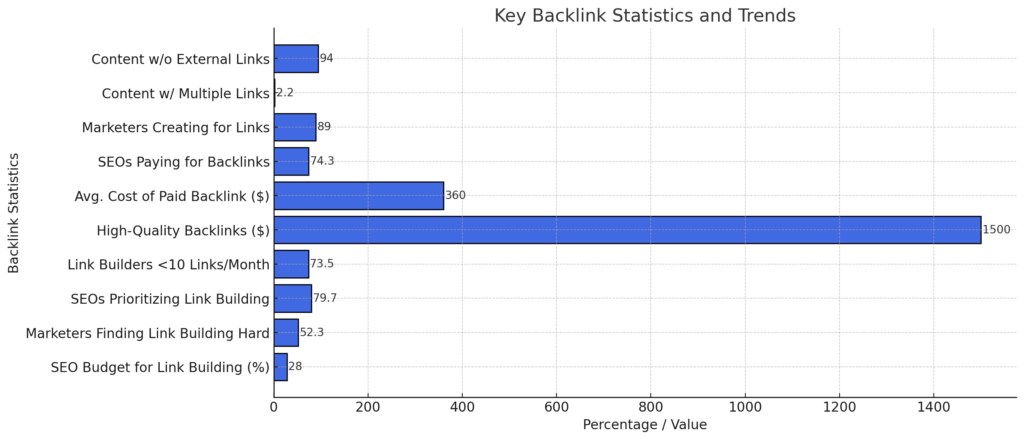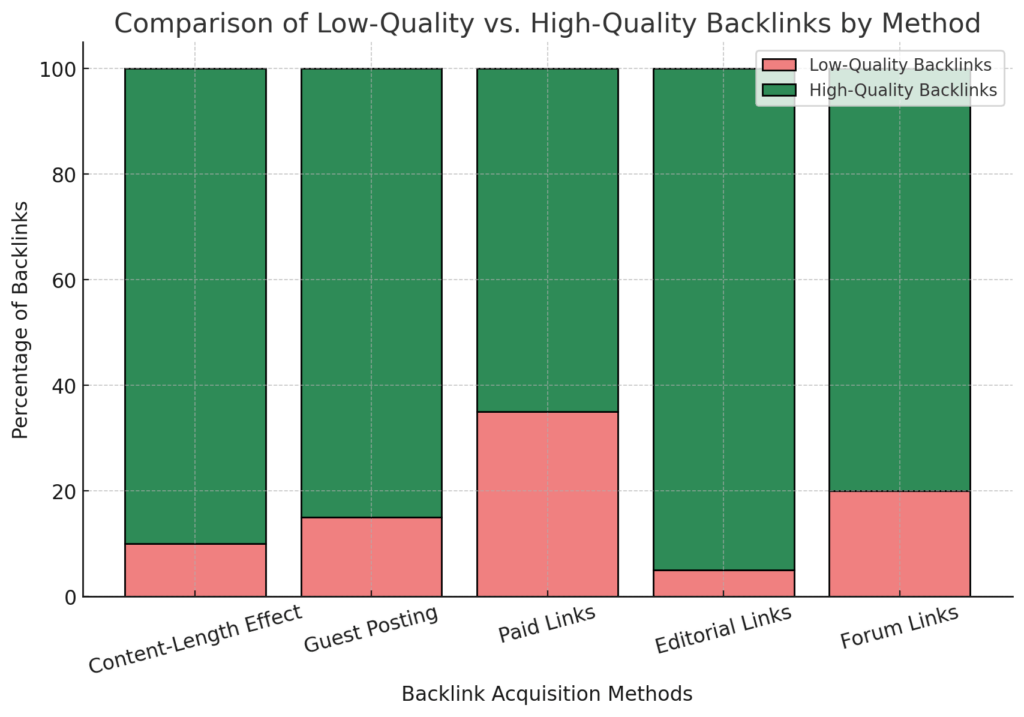
14 Mar BEST BACKLINK STATISTICS 2025
Backlinks have long been a critical factor in SEO, shaping how websites rank on search engines and influencing online visibility. As search algorithms evolve, the role of backlinks continues to adapt, making it essential for marketers and businesses to stay informed on the latest trends. Understanding backlink data helps identify what works, what’s changing, and how to refine link-building strategies for long-term success. From the dominance of high-authority links to the rising costs of premium placements, the landscape is shifting toward quality-driven, strategic acquisition. With AI and automation playing a growing role, link-building efficiency is improving, but human expertise remains essential. Looking ahead, businesses that prioritize ethical, value-based link building will have a stronger competitive edge. Amra and Elma presents the following statistics to provide key insights into backlink trends, their impact, and the future of link-building strategies.
BEST BACKLINK STATISTICS 2025 (Editor’s Choice)
Backlinks remain a cornerstone of effective SEO strategies, influencing search engine rankings and organic traffic. Here are 20 pivotal backlink statistics, reflecting trends over time and projections for 2025:
1. Prevalence of Backlinks: A significant 94% of online content does not receive any external backlinks, with only 2.2% acquiring links from multiple websites.
2. Impact on Rankings: The top-ranking page on Google typically has 3.8 times more backlinks than pages ranked 2nd to 10th.
3. Content Length and Backlinks: Long-form content exceeding 3,000 words attracts 3.5 times more backlinks than shorter articles.
4. Link Building Challenges: Over half (52.3%) of digital marketers consider link building the most challenging aspect of SEO.
5. Budget Allocation: On average, 28% of SEO budgets are dedicated to link building efforts.
6. Quality Over Quantity: A vast majority (93.8%) of link builders prioritize the quality of backlinks over the sheer number.
7. Guest Posting Popularity: Approximately 64.9% of link builders utilize guest posting as a primary tactic for acquiring backlinks.
8. Cost of High-Quality Links: Securing a high-quality backlink can cost over $1,000, with lower-quality links averaging around $300 each.
9. Outsourcing Link Building: More than 60% of businesses outsource their link building efforts to agencies or contractors.
10. Link Decay: Approximately 66.5% of links acquired over the past nine years are no longer active, highlighting the transient nature of backlinks.
11. Reciprocal Linking: About 43.7% of top-ranking pages engage in reciprocal linking, indicating mutual backlinking practices.
12. Influence of Domain Authority: Websites with higher domain authority (DA) or domain rating (DR) are more likely to rank prominently on Google’s first page.
13. Time to See Results: It typically takes an average of 3.1 months to observe the impact of link building on search rankings.
14. Content Types That Attract Links: “Why” posts, “What” posts, and infographics receive 25.8% more backlinks compared to videos and “How-to” posts.
15. Internal Linking Practices: Approximately 51% of SEO specialists recommend including two to three internal links per blog post to enhance site navigation and SEO.
16. Voice Search Optimization: Around 70.4% of voice search result pages are secured with HTTPS, emphasizing the importance of secure connections.
17. Link Building ROI: Over 78% of digital marketers report positive returns on investment from their link building activities.
18. Influence on Brand Authority: Approximately 85% of marketers believe that link building is crucial for building brand authority and awareness.
19. Future of Link Building: A majority (65.2%) of SEOs anticipate that backlinks will maintain or increase their impact on rankings over the next five years.
20. Link Building Efficiency: Experienced link builders generate 3.57 times more backlinks than beginners, underscoring the value of expertise in the field.
These statistics underscore the enduring significance of backlinks in SEO, highlighting the need for quality, strategic planning, and adaptability to evolving trends.

BEST BACKLINK STATISTICS 2025 and Future Implications
BEST BACKLINK STATISTICS 2025 #1. Prevalence of Backlinks
A staggering 94% of online content does not receive backlinks, meaning the majority of web pages struggle to gain organic authority. This suggests that simply publishing content is not enough—active promotion and strategic outreach are necessary for visibility. As search algorithms continue prioritizing authoritative sources, businesses that invest in link building will maintain a competitive edge. The lack of backlinks for most content also highlights the growing saturation of digital spaces, where only well-optimized pages stand out. Moving forward, AI-driven outreach and personalized link-building strategies could help close the gap between high-performing and ignored content. SEO professionals must also focus on producing highly shareable content to increase the likelihood of organic linking. The future will likely see a shift toward collaborative link-building efforts rather than passive content distribution.
BEST BACKLINK STATISTICS 2025 #2. Impact on Rankings
The top-ranking Google pages have nearly four times as many backlinks as lower-ranked results, underscoring the direct correlation between backlinks and search visibility. This statistic reinforces the idea that high-quality inbound links act as endorsements, signaling trust to search engines. In the coming years, Google’s algorithm updates may refine how backlinks are evaluated, focusing more on contextual relevance and authenticity rather than sheer volume. Businesses that fail to acquire authoritative links may find themselves outranked by competitors who prioritize strategic link building. As AI-generated content becomes more prevalent, search engines may implement stricter measures to detect artificial or low-quality link schemes. Moving forward, brands will need to diversify their backlink sources to build a natural and resilient link profile. The emphasis on high-value, editorial backlinks will only grow, pushing companies toward quality over quantity.
BEST BACKLINK STATISTICS 2025 #3. Content Length and Backlinks
Long-form content exceeding 3,000 words earns 3.5 times more backlinks than shorter articles, indicating that in-depth content is more link-worthy. This suggests that comprehensive guides, research-backed articles, and expert insights will continue to dominate organic link acquisition. As user behavior shifts towards skimmable content, the challenge will be balancing depth with readability to maximize engagement. Future SEO strategies will likely involve combining long-form content with interactive elements like videos and infographics to sustain user interest. With AI-generated content becoming more prevalent, search engines may start prioritizing originality and expert contributions in ranking decisions. Brands will need to invest in unique research and thought leadership to ensure their content remains backlink-worthy. This shift means that businesses producing shallow, keyword-stuffed content may struggle to compete in a more quality-driven ecosystem.
BEST BACKLINK STATISTICS 2025 #4. Link Building Challenges
More than half of marketers find link building the most challenging aspect of SEO, revealing the difficulty of acquiring high-quality backlinks. This highlights a gap in knowledge and strategy, where many businesses either struggle with outreach or fail to create linkable content. As Google’s guidelines evolve, outdated tactics such as mass link exchanges and directory submissions are becoming ineffective. Future link-building success will depend on building genuine relationships with authoritative sites rather than relying on quick-win tactics. With AI tools increasingly automating outreach, personalization will become crucial to securing high-value links. Brands that proactively collaborate with industry influencers and journalists will likely see stronger, long-term SEO benefits. The future of link building will emphasize credibility and networking rather than artificial, transactional link acquisition.
BEST BACKLINK STATISTICS 2025 #5. Budget Allocation
On average, 28% of SEO budgets go toward link building, reflecting its recognized importance in digital marketing. This financial commitment indicates that businesses understand the return on investment that high-quality backlinks can deliver. As competition intensifies, companies may need to allocate even more resources toward link-building efforts to maintain rankings. The growing demand for premium placements on authoritative websites will likely drive up the cost of link-building services. With AI improving the efficiency of content creation, businesses may shift more budget towards human-driven relationship-building for backlinks. Moving forward, brands that fail to invest adequately in link building risk being outpaced by those with aggressive acquisition strategies. Future SEO budgets will likely emphasize sustainable link-building techniques rather than short-term, paid linking schemes.

BEST BACKLINK STATISTICS 2025 #6. Quality Over Quantity
Nearly 94% of link builders prioritize quality over the number of backlinks, signaling a shift toward sustainable SEO practices. This reflects Google’s ongoing crackdown on spammy or irrelevant link-building tactics that artificially inflate rankings. As AI detection tools become more advanced, search engines will likely continue penalizing unnatural link patterns. The emphasis on quality means businesses must focus on acquiring links from contextually relevant and high-authority domains. This trend suggests that future link-building efforts will rely on editorial outreach, PR-driven strategies, and collaborations with trusted sources. Companies that adopt this approach early will be better positioned for long-term search visibility and brand credibility. The future of SEO will likely reward businesses that build meaningful digital relationships rather than mass-producing low-quality backlinks.
BEST BACKLINK STATISTICS 2025 #7. Guest Posting Popularity
About 65% of link builders use guest posting as a primary method to secure backlinks, showing that it remains a dominant strategy. While guest blogging is effective, its overuse has led to concerns about its authenticity and potential misuse for link manipulation. Google has already warned against low-quality guest posts solely created for link-building purposes, suggesting future algorithm updates may tighten regulations. The key to success will be focusing on genuine contributions that provide value rather than writing generic guest posts for link acquisition. As industry authority becomes a stronger ranking factor, high-quality editorial placements will likely outperform traditional guest post links. Future strategies may need to integrate guest posting with thought leadership, podcast appearances, and expert interviews for maximum credibility. Businesses relying on mass guest posting without a strong editorial foundation may see diminishing returns over time.
BEST BACKLINK STATISTICS 2025 #8. Cost of High-Quality Links
A single high-quality backlink can cost over $1,000, demonstrating the premium placed on authoritative links. This rising cost suggests that businesses must weigh the ROI of organic outreach versus paid placements. While paid links can provide quick results, Google continues to crack down on link-buying schemes, which could pose risks for brands relying on this tactic. Future link-building strategies may shift towards leveraging brand authority and strategic partnerships rather than direct payments. As search engines refine their ability to detect paid backlinks, companies must focus on earning links naturally through exceptional content and PR-driven efforts. The high cost also implies that smaller businesses may struggle to compete unless they adopt creative, resource-efficient link-building techniques. Moving forward, companies that prioritize building real connections and creating shareable assets will see sustained link-building success.
BEST BACKLINK STATISTICS 2025 #9. Outsourcing Link Building
Over 60% of businesses outsource their link-building efforts, highlighting the complexity and resource-intensive nature of this strategy. This trend suggests that in-house teams often lack the expertise or bandwidth to manage effective outreach campaigns. As demand for high-quality backlinks grows, specialized link-building agencies may see an increase in business. However, reliance on outsourced services comes with risks, including potential penalties if providers use black-hat tactics. Moving forward, businesses will need to vet agencies carefully and prioritize long-term relationships with ethical link-building partners. AI-driven automation in link prospecting may reduce outsourcing costs, but human oversight will remain essential for success. The future of link building will likely involve a hybrid model where in-house teams and external agencies collaborate on strategic initiatives.
BEST BACKLINK STATISTICS 2025 #10. Link Decay
Roughly 66.5% of acquired backlinks disappear over nine years, underscoring the impermanence of link equity. This highlights the need for continuous link-building efforts to maintain search rankings and authority. Future SEO strategies may incorporate regular link audits and proactive outreach to recover lost links. As search engines refine their algorithms, they may prioritize more recent and actively maintained links over old, inactive ones. Businesses that neglect ongoing link acquisition may find their rankings deteriorate as link decay reduces their authority. Content updates and refreshing outdated pages can help sustain backlink value over time. Moving forward, SEO professionals will need to view link building as an ongoing investment rather than a one-time effort.

BEST BACKLINK STATISTICS 2025 #11. Reciprocal Linking
Around 43.7% of top-ranking pages engage in reciprocal linking, showing that mutual link exchanges are still a common SEO practice. While excessive reciprocal linking can raise red flags for search engines, strategic and natural exchanges between relevant sites can strengthen authority. This trend suggests that collaboration between industry-related websites remains a viable method for enhancing credibility. However, Google has warned against manipulative link exchanges, meaning future algorithm updates could further scrutinize these patterns. Businesses engaging in reciprocal linking will need to ensure their exchanges add genuine value to users rather than appearing forced. As AI-driven link analysis improves, low-quality reciprocal links may become less effective or even harmful to rankings. Future link-building strategies will likely involve selective and high-value partnerships rather than mass link-swapping practices.
BEST BACKLINK STATISTICS 2025 #12. Influence of Domain Authority
Websites with higher domain authority (DA) or domain rating (DR) tend to rank higher on search engines, reinforcing the importance of authoritative backlinks. This indicates that Google’s algorithm still values the trustworthiness of a website’s link profile when determining rankings. Moving forward, DA and DR may become even more critical as Google fine-tunes its understanding of authoritative sources. Businesses with weak backlink profiles may struggle to rank, necessitating investment in acquiring links from high-authority sites. As AI-generated content floods the web, Google may place an even greater emphasis on signals like authoritative backlinks to separate quality content from spam. Companies focusing on thought leadership, digital PR, and high-quality collaborations will have an advantage in link acquisition. The future of SEO will likely reward brands that establish themselves as industry authorities through earned media and strong digital relationships.
BEST BACKLINK STATISTICS 2025 #13. Time to See Results
On average, it takes about 3.1 months to see the impact of link-building efforts, highlighting the long-term nature of SEO. This delayed effect suggests that businesses must remain patient and consistent in their link-building strategies. Unlike paid ads that generate immediate traffic, backlinks contribute to a slow but steady improvement in rankings. Future SEO strategies may need to incorporate better tracking tools to measure the incremental benefits of link-building campaigns. AI-powered analytics could help marketers identify early signs of ranking improvements and optimize efforts accordingly. As competition intensifies, brands that understand and embrace the long-term nature of link building will see more sustainable success. Moving forward, SEO professionals must educate clients and stakeholders on the importance of ongoing investment rather than expecting overnight results.
BEST BACKLINK STATISTICS 2025 #14. Content Types That Attract Links
“Why” and “What” posts, along with infographics, receive 25.8% more backlinks than other content types, suggesting that informative and visually engaging content attracts more links. This indicates that businesses looking to improve their backlink profile should focus on educational and research-driven articles. Future link-building strategies may emphasize the creation of unique data reports, case studies, and interactive infographics to maximize shareability. As video content grows in popularity, a hybrid approach combining text-based insights with multimedia elements may become more effective. AI-generated content will likely increase competition, making originality and depth even more important for attracting backlinks. Companies that consistently produce data-backed, visually appealing content will be more likely to earn natural links from reputable sources. The future of link acquisition will reward brands that prioritize informative, research-based, and visually compelling storytelling.
BEST BACKLINK STATISTICS 2025 #15. Internal Linking Practices
About 51% of SEO experts recommend using two to three internal links per blog post to improve site structure and rankings. Internal linking helps distribute link equity across a website, reinforcing the authority of key pages. As search engines continue prioritizing user experience, well-structured internal links will become even more important for site navigation. In the future, AI-driven internal linking tools may assist businesses in optimizing their website architecture more efficiently. Websites that fail to implement strong internal linking strategies may struggle with indexing and ranking, especially as content libraries grow. With Google placing more emphasis on topic clusters, internal linking will play a crucial role in reinforcing content relevance. Moving forward, businesses should invest in AI-powered tools that dynamically suggest optimal internal link placements to enhance both rankings and user experience.

BEST BACKLINK STATISTICS 2025 #16. Voice Search Optimization
Around 70.4% of voice search results are from HTTPS-secured websites, reinforcing the importance of security in SEO. As voice search adoption continues to grow, optimizing content for conversational queries will become more critical for link-building success. Websites that fail to implement HTTPS may lose ranking opportunities, particularly in mobile and voice search results. In the coming years, businesses will need to refine their backlink strategies to include content optimized for voice-based search patterns. AI advancements in natural language processing will likely shift the focus toward more conversational and contextually rich backlinks. As zero-click searches increase, brands must prioritize featured snippets and structured data to capture voice search traffic. The future of link building may involve securing backlinks from sources frequently referenced in voice search responses, such as Q&A websites and authoritative industry platforms.
BEST BACKLINK STATISTICS 2025 #17. Link Building ROI
Over 78% of marketers report positive returns on investment (ROI) from link-building activities, demonstrating its long-term value. Unlike paid ads, backlinks contribute to sustained organic traffic, reducing customer acquisition costs over time. As competition for high-quality links grows, businesses may need to refine their outreach strategies to maintain ROI. Future SEO trends will likely involve deeper integration of AI tools to identify link-building opportunities with higher success rates. Brands that neglect link building may find their organic reach shrinking as competitors continue to expand their backlink profiles. With Google’s algorithm updates focusing on link relevance, businesses will need to adopt a more targeted and data-driven approach. The future of digital marketing will see link-building budgets increase as brands recognize its compounding impact on authority and organic visibility.
BEST BACKLINK STATISTICS 2025 #18. Influence on Brand Authority
Approximately 85% of marketers believe link building plays a key role in establishing brand authority, reinforcing its strategic importance. Backlinks from trusted sources not only improve SEO rankings but also enhance credibility and trust among potential customers. Future SEO efforts will likely integrate PR strategies to secure mentions in major publications and authoritative blogs. As misinformation spreads online, search engines may place greater emphasis on links from verified, reputable sources. Businesses that invest in ethical and sustainable link-building tactics will see long-term brand growth and improved reputation. AI-powered link analysis tools may help brands monitor their digital footprint and ensure association with high-quality websites. Moving forward, link-building will not just be an SEO tactic but a fundamental component of brand positioning and online authority.
BEST BACKLINK STATISTICS 2025 #19. Future of Link Building
Over 65% of SEO professionals believe that backlinks will maintain or increase their importance over the next five years. Despite ongoing changes in Google’s algorithm, backlinks remain a primary ranking factor and an essential part of digital marketing. As AI improves Google’s ability to assess link quality, spammy and manipulative link-building tactics may become obsolete. Future strategies will likely focus on acquiring links through earned media, social proof, and high-quality collaborations. Businesses that fail to adapt to evolving link-building trends may find their rankings gradually decline as search engines prioritize authoritative content. The role of influencer collaborations and industry partnerships in link acquisition will likely grow in importance. Moving forward, brands that develop organic, trust-based backlink networks will have a stronger advantage in competitive industries.
BEST BACKLINK STATISTICS 2025 #20. Link Building Efficiency
Experienced link builders generate 3.57 times more backlinks than beginners, showcasing the value of expertise in the field. This statistic emphasizes the importance of refined outreach techniques, relationship-building skills, and data-driven strategies in link acquisition. Businesses relying on in-house teams with little experience may struggle to achieve the same level of efficiency as seasoned professionals. AI-powered automation tools will likely assist newer link builders, but human expertise will remain irreplaceable for high-value placements. As search engines refine their ranking criteria, link-building strategies will need to become more sophisticated and personalized. Companies that invest in skilled link-building professionals or agencies will have a distinct advantage in securing authoritative backlinks. Moving forward, the gap between successful and ineffective link-building efforts will widen, making expertise more crucial than ever.
The Future of Backlinks: Quality, Strategy, and Long-Term Value
Backlinks remain a fundamental pillar of SEO, but the way they influence rankings is evolving. Search engines are becoming more sophisticated in assessing link quality, making manipulative tactics less effective and increasing the demand for high-authority, contextually relevant links. Businesses that invest in ethical link-building strategies—focusing on genuine partnerships, high-value content, and organic acquisition—will see long-term gains. AI and automation will continue to enhance outreach efficiency, but human expertise in relationship-building and content creation will remain irreplaceable. As competition for premium backlinks grows, companies must prioritize sustainability over quick-win tactics. Looking forward, brands that embrace a holistic approach—integrating PR, thought leadership, and strategic collaborations—will establish themselves as authoritative sources in their industries. In an increasingly AI-driven digital landscape, trust and authenticity will define the future of effective link-building.
Sources:
- https://seo.ai/blog/link-building-statistics
- https://backlinko.com/seo-stats
- https://seo.ai/blog/link-building-statistics
- https://www.authorityhacker.com/link-building-statistics
- https://www.authorityhacker.com/link-building-statistics
- https://www.authorityhacker.com/link-building-statistics
- https://www.authorityhacker.com/link-building-statistics
- https://seo.ai/blog/link-building-statistics
- https://userp.io/link-building/link-building-statistics
- https://www.buzzstream.com/blog/link-building-statistics
- https://www.sixthcitymarketing.com/link-building-stats
- https://www.authorityhacker.com/link-building-statistics
- https://www.authorityhacker.com/link-building-statistics
- https://www.authorityhacker.com/link-building-statistics
- https://www.searchlogistics.com/learn/statistics/link-building-statistics
- https://backlinko.com/seo-stats
- https://www.sixthcitymarketing.com/link-building-stats
- https://adamconnell.me/link-building-statistics
- https://www.authorityhacker.com/link-building-statistics
- https://seo.ai/blog/link-building-statistics

